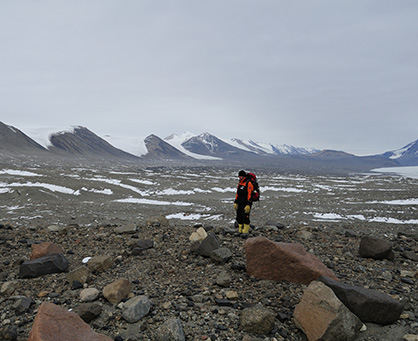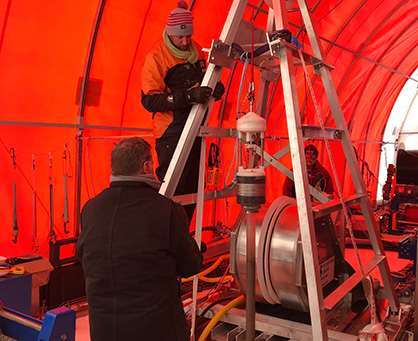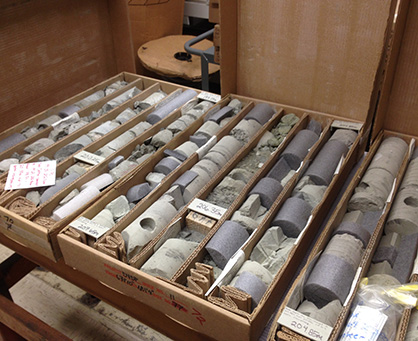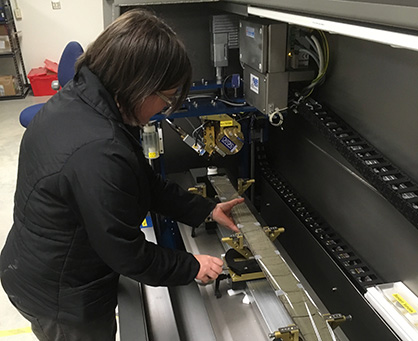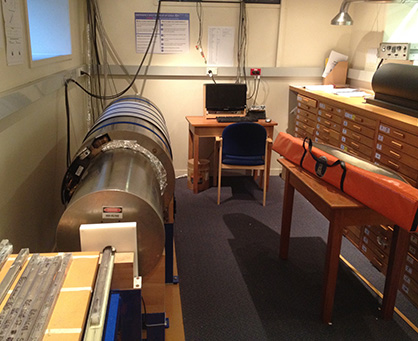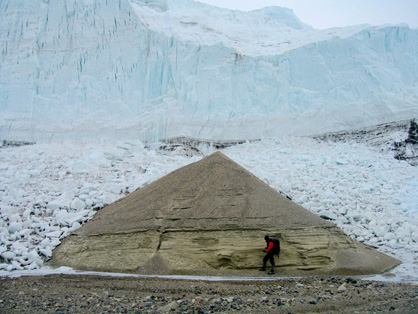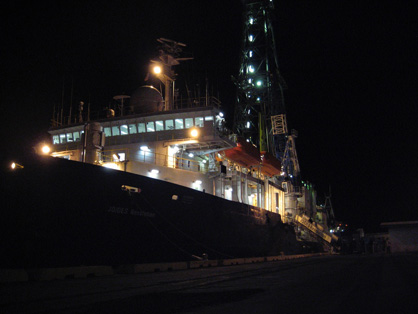2023
Journal - Research Article
Baxter, R. J. M., White, J. D. L., Ohneiser, C., & Brenna, M. (2023). Reconstruction of subaqueous eruption-fed current characteristics and source location using anisotropy of magnetic susceptibility (AMS) at Otapahi, Dunedin Volcano, New Zealand. Journal of Geophysical Research: Solid Earth, 128, e2022JB025605. doi: 10.1029/2022JB025605
Ohneiser, C., Hulbe, C. L., Beltran, C., Riesselman, C. R., Moy, C. M., Condon, D. B., & Worthington, R. A. (2023). West Antarctic ice volume variability paced by obliquity until 400,000 years ago. Nature Geoscience, 16, 44-49. doi: 10.1038/s41561-022-01088-w
Chorley, H., Levy, R., Naish, T., Lewis, A., Cox, S., Hemming, S., Ohneiser, C., Gorman, A., … Anderson, J., Dagg, B., & Lurcock, P. (2023). East Antarctic Ice Sheet variability during the middle Miocene Climate Transition captured in drill cores from the Friis Hills, Transantarctic Mountains. Geological Society of America Bulletin, 135(5-6), 1503-1529. doi: 10.1130/b36531.1
Conference Contribution - Published proceedings: Abstract
Ruz Ginouves, J. A., White, J. D. L., Fierstein, J., Ohneiser, C., & Nelson, F. (2023). Heating temperatures of muddy country rock during dike emplacement. In G. E. Frontin-Rollett & S. D. Nodder (Eds.), Geoscience Society of New Zealand Miscellaneous Publication. 164A, (pp. 214). Wellington, New Zealand: Geoscience Society of New Zealand. [Abstract]
Levy, R., Naish, T., Beltran, C., Duncan, B., Ohneiser, C., Seki, O., … Chorley, H. (2023). East Antarctic ice sheet variability during the Middle Miocene Climate Transition captured in drill cores from the Friis Hills, Transantarctic Mountains. Proceedings of the New Zealand-Australia Antarctic Science Conference (NZAASC): Latitudes of Change. (pp. 95-96). Retrieved from https://www.nzaasc.org
2022
Journal - Research Article
Bollen, M., Riesselman, C. R., Ohneiser, C., Albot, O., McKay, R., Lee, M. K., … Levy, R. (2022). Pleistocene oceanographic variability in the Ross Sea: A multiproxy approach to age model development and paleoenvironmental analyses. Global & Planetary Change, 216, 103901. doi: 10.1016/j.gloplacha.2022.103901
Patterson, M. O., Levy, R. H., Kulhanek, D. K., van de Flierdt, T., Horgan, H., Dunbar, G. B., … Ohneiser, C., … the SWAIS 2C Science Team. (2022). Sensitivity of the West Antarctic Ice Sheet to +2°C (SWAIS 2C). Scientific Drilling, 30, 101-112. doi: 10.5194/sd-30-101-2022
Baxter, R. J. M., White, J. D. L., Brenna, M., & Ohneiser, C. (2022). Pre-eruption magma staging at the long-lived intraplate Dunedin Volcano, New Zealand. Terra Nova, 34, 253-263. doi: 10.1111/ter.12585
Martínez-Pérez, C., Greening, C., Bay, S. K., Lappan, R. J., Zhao, Z., De Corte, D., Hulbe, C., Ohneiser, C., … Thomson, B., … Morales, S. E., & Baltar, F. (2022). Phylogenetically and functionally diverse microorganisms reside under the Ross Ice Shelf. Nature Communications, 13, 117. doi: 10.1038/s41467-021-27769-5
2021
Journal - Research Article
Beltran, C., Sicre, M.-A., Ohneiser, C., & Sainz, M. (2021). A composite Pliocene record of sea surface temperature in the central Mediterranean (Capo Rossello composite section – South Sicily). Sedimentary Geology, 420, 105921. doi: 10.1016/j.sedgeo.2021.105921
Conference Contribution - Published proceedings: Abstract
Wilsher, C., Ohneiser, C., Beltran, C., Lee, D., Salzmann, U., & Amoo, M. (2021). A magnetostratigraphy of the eocene to oligocene Orepuki core. In A. V. Zernack & J. Palmer (Eds.), Geoscience Society of New Zealand Miscellaneous Publication. 158, (pp. 318). Wellington, New Zealand: Geoscience Society of New Zealand. [Abstract]
Burns, J., Ohneiser, C., Dunbar, G., Levy, R., & McKay, R. (2021). Paleomagnetism of sediment cores from Coulman High, Antarctica. In A. V. Zernack & J. Palmer (Eds.), Geoscience Society of New Zealand Miscellaneous Publication. 158, (pp. 27). Wellington, New Zealand: Geoscience Society of New Zealand. [Abstract]
Hulbe, C., Dunbar, G., Horgan, H., Levy, R., Mandeno, D., Ohneiser, C., … Stevens, C. (2021). The Aotearoa New Zealand Ross Ice Shelf research programme: Connecting modern process studies with past and future ice sheet system behaviour [Keynote]. Proceedings of the New Zealand Antarctic Science Conference: Connecting through change. (pp. 28-29). Retrieved from https://www.antarcticanz.govt.nz/nzasc21
2020
Journal - Research Article
Stevens, C., Hulbe, C., Brewer, M., Stewart, C., Robinson, N., Ohneiser, C., & Jendersie, S. (2020). Ocean mixing and heat transport processes observed under the Ross Ice Shelf control its basal melting. PNAS, 117(29), 16799-16804. doi: 10.1073/pnas.1910760117
Ohneiser, C., Wilson, G. S., Beltran, C., Dolan, A. M., Hill, D. J., & Prebble, J. G. (2020). Warm fjords and vegetated landscapes in early Pliocene East Antarctica. Earth & Planetary Science Letters, 534, 116045. doi: 10.1016/j.epsl.2019.116045
Beltran, C., Golledge, N. R., Ohneiser, C., Kowalewski, D. E., Marie-Alexandrine, S., Hageman, K. J., Smith, R., Wilson, G. S., & Mainié, F. (2020). Southern Ocean temperature records and ice-sheet models demonstrate rapid Antarctic ice sheet retreat under low atmospheric CO2 during Marine Isotope Stage 31. Quaternary Science Reviews, 228, 106069. doi: 10.1016/j.quascirev.2019.106069
Perkins, E. J., Gorman, A. R., Tidey, E. J., Wilson, G. S., Ohneiser, C., Moy, C. M., Riesselman, C. R., Gilmer, G., & Ross, B. S. (2020). High-resolution seismic imaging reveals infill history of a submerged Quaternary fjord system in the subantarctic Auckland Islands, New Zealand. Quaternary Research, 93(1), 255-266. doi: 10.1017/qua.2019.58
Ohneiser, C., & Tapia, C. (2020). Diagenesis of magnetic minerals at the Southwest Pacific DSDP Site 277. New Zealand Journal of Geology & Geophysics, 63(2), 250-261. doi: 10.1080/00288306.2019.1665075
Conference Contribution - Published proceedings: Abstract
Beltran, C., Ohneiser, C., Moy, C., Riesselman, C., Kerr, G., Armstrong, E., & Frew, R. (2020). The University of Otago Organic Geochemistry Research Facility: A new Research Centre for Paleoenvironment and Paleoclimate studies focussed on the Southern Ocean and Antarctica. In K. N. Bassett, A. R. L. Nichols & C. H. Fenton (Eds.), Geoscience Society of New Zealand Miscellaneous Publication. 157A, (pp. 39). Wellington, New Zealand: Geoscience Society of New Zealand. [Abstract]
Wilsher, C., Ohneiser, C., Beltran, C., Riesselman, C., & Lee, D. (2020). Paleoclimate reconstruction of Orepuki-1 sedimentary drill core: Initial results. In K. N. Bassett, A. R. L. Nichols & C. H. Fenton (Eds.), Geoscience Society of New Zealand Miscellaneous Publication. 157A, (pp. 318). Wellington, New Zealand: Geoscience Society of New Zealand. [Abstract]
Ohneiser, C., Beltran, C., Hulbe, C., Moy, C., Riesselman, C., Worthington, R., & Condon, D. (2020). Obliquity pacing of Antarctic glaciations during the Quaternary. In K. N. Bassett, A. R. L. Nichols & C. H. Fenton (Eds.), Geoscience Society of New Zealand Miscellaneous Publication. 157A, (pp. 201). Wellington, New Zealand: Geoscience Society of New Zealand. [Abstract]
Brenna, M., Ohneiser, C., Gorman, A., & Palin, M. (2020). Geothermal energy from extinct volcanoes: The Dunedin experiment. Proceedings of the 14th Annual Otago Energy Research Centre (OERC) Symposium: New Energy Futures post COVID-19. Retrieved from https://www.otago.ac.nz/oerc
Martin, A., Dunbar, G., Hulbe, C., Ohneiser, C., Grant, G., & Brandt, S. (2020). Provenance of gravel- and sand-sized sediment from both the ice shelf and shallowest seafloor at the HWD-2b site, mid Ross Ice Shelf, Antarctica. Proceedings of the XXXVI Scientific Committee on Antarctic Research (SCAR) 9th Open Science Conference: Antarctic Science: Global Connections. 1539. Retrieved from https://www.scar2020.org
Ohneiser, C., Beltran, C., Hulbe, C., Moy, C., Riesselman, C., Worthington, R., & Condon, D. (2020). Obliquity paced oscillations of the Ross Ice Shelf during the quaternary. Proceedings of the XXXVI Scientific Committee on Antarctic Research (SCAR) 9th Open Science Conference: Antarctic Science: Global Connections. 996. Retrieved from https://www.scar2020.org
Levy, R., Patterson, M., van de Flierdt, T., Espejo, F., Stocchi, P., Klages, J., … Ohneiser, C., & Flores, J.-A. (2020). The SWAIS 2C project: Sensitivity of the West Antarctic Ice Sheet in a warmer world. Proceedings of the XXXVI Scientific Committee on Antarctic Research (SCAR) 9th Open Science Conference: Antarctic Science: Global Connections. 1598. Retrieved from https://www.scar2020.org
Chorley, H., Levy, R., Naish, T., Hemming, S., Ohneiser, C., Prebble, J., … Florindo, F. (2020). Orbital-scale, glacial evolution of the Transantarctic mountains during the Miocene Climatic Optimum and its termination (˜15.5-13.8 Ma). Proceedings of the XXXVI Scientific Committee on Antarctic Research (SCAR) 9th Open Science Conference: Antarctic Science: Global Connections. 615. Retrieved from https://www.scar2020.org
Beltran, C., Golledge, N. R., Ohneiser, C., Kowalewski, D. E., Sicre, M.-A., Hageman, K. J., Smith, R. O., Wilson, G. S., & Mainié, F. (2020). Rapid Antarctic ice sheet retreat under low atmospheric CO2. Proceedings of European Geosciences Union (EGU): Sharing Geoscience Online. EGU2020-12028. doi: 10.5194/egusphere-egu2020-12028
Ohneiser, C., Beltran, C., Hulbe, C., Moy, C., Riesselman, C., Worthington, R., & Condon, D. (2020). Obliquity pacing of Antarctic glaciations during the Quaternary. Proceedings of European Geosciences Union (EGU): Sharing Geoscience Online. EGU2020-11191. doi: 10.5194/egusphere-egu2020-11191
Baltar, F., De Corte, D., Ohneiser, C., Thomson, B., Greening, C., Stepanauskas, R., … Morales, S., Hulbe, C. L., … Martínez-Pérez, C. (2020). Chemoautotrophy drives plankton activity under the Ross Ice Shelf. Proceedings of the Ocean Sciences Meeting (OSM). OB44G-0761. Retrieved from https://agu.confex.com/agu/osm20/meetingapp.cgi
2019
Journal - Research Article
Cole, R. P., Ohneiser, C., White, J. D. L., Townsend, D. B., & Leonard, G. S. (2019). Paleomagnetic evidence for cold emplacement of eruption-fed density current deposits beneath an ancient summit glacier, Tongariro volcano, New Zealand. Earth & Planetary Science Letters, 522, 155-165. doi: 10.1016/j.epsl.2019.07.004
Gangl, S. K., Moy, C. M., Stirling, C. H., Jenkyns, H. C., Crampton, J. S., Clarkson, M. O., Ohneiser, C., & Porcelli, D. (2019). High-resolution records of Oceanic Anoxic Event 2: Insights into the timing, duration and extent of environmental perturbations from the palaeo-South Pacific Ocean. Earth & Planetary Science Letters, 518, 172-182. doi: 10.1016/j.epsl.2019.04.028
Jovane, L., Florindo, F., Acton, G., Ohneiser, C., Sagnotti, L., Strada, E., … Wilson, G. S., … Passchier, S. (2019). Miocene glacial dynamics recorded by variations in magnetic properties in the ANDRILL‐2A drill core. Journal of Geophysical Research: Solid Earth, 124, 2297-2312. doi: 10.1029/2018JB016865
Ohneiser, C., Yoo, K.-C., Albot, O. B., Cortese, G., Riesselman, C., Lee, J. I., … Bollen, M., … Beltran, C., … Wilson, G. S. (2019). Magneto-biostratigraphic age models for Pleistocene sedimentary records from the Ross Sea. Global & Planetary Change, 176, 36-49. doi: 10.1016/j.gloplacha.2019.02.013
Tapia, C. A., Grant, G. R., Turner, G. M., Sefton, J. P., Naish, T. R., Dunbar, G., & Ohneiser, C. (2019). High-resolution magnetostratigraphy of mid-Pliocene (3.3-3.0 Ma) shallow-marine sediments, Whanganui Basin, New Zealand. Geophysical Journal International, 217(1), 41-57. doi: 10.1093/gji/ggz004
Conference Contribution - Published proceedings: Abstract
Hulbe, C., Stevens, C., Dunbar, G., Ohneiser, C., Brewer, M., Mandeno, D., & Pyne, A. (2019). Beyond J9: New observations of the hidden ocean and sea floor sediments beneath the Ross Ice Shelf, West Antarctica. In J. Hong & N. C. Pant (Eds.), Proceedings of the XIII International Symposium on Antarctic Earth Science (ISAES). A121. Cambridge, UK: SCAR. doi: 10.5281/zenodo.7997445
Jovane, L., Florindo, F., Acton, G., Ohneiser, C., Sagnotti, L., Strada, E., … Wilson, G., … Passchier, S. (2019). Miocene glacial dynamics recorded by variations in magnetic properties in the ANDRILL-2A drill core. Geophysical Research Abstracts, 21, EGU2019-5081. [Abstract]
Ohneiser, C., & Wilson, G. (2019). Eccentricity-paced Southern Hemisphere glacial-interglacial cyclicity preceding the middle Miocene climatic transition. Geophysical Research Abstracts, 21, EGU2019-2123. [Abstract]
Bollen, M., Riesselman, C., Dunbar, R., Mucciarone, D., DeJong, H., Ohneiser, C., & DiTullio, G. (2019). Effects of environmental conditions on diatom communities and the δ13C of particulate organic matter in Terra Nova Bay. Proceedings of the New Zealand Antarctic Science Conference: Our future in focus. (pp. 39). New Zealand Antarctic Research Institute. Retrieved from https://www.antarcticanz.govt.nz/science/new-zealand-antarctic-science-conference-2019
Stevens, C., Hulbe, C., Brewer, M., Stewart, C., Robinson, N., Ohneiser, C., … Wilson, G., & Riesselman, C. (2019). There and back again: Oceanic connections between the grounding line and the Southern Ocean. Proceedings of the New Zealand Antarctic Science Conference: Our future in focus. (pp. 37). New Zealand Antarctic Research Institute. Retrieved from https://www.antarcticanz.govt.nz/science/new-zealand-antarctic-science-conference-2019
Hulbe, C., Stevens, C., Dunbar, G., & Ohneiser, C. (2019). A closer look: New observations of the marine environment and sea floor sediments below the central Ross Ice Shelf. Proceedings of the New Zealand Antarctic Science Conference: Our future in focus. (pp. 28). New Zealand Antarctic Research Institute. Retrieved from https://www.antarcticanz.govt.nz/science/new-zealand-antarctic-science-conference-2019
2018
Journal - Research Article
Grant, G. R., Sefton, J. P., Patterson, M. O., Naish, T. R., Dunbar, G. B., Hayward, B. W., … Ohneiser, C., & Turner, G. M. (2018). Mid- to late Pliocene (3.3–2.6 Ma) global sea-level fluctuations recorded on a continental shelf transect, Whanganui Basin, New Zealand. Quaternary Science Reviews, 201, 241-260. doi: 10.1016/j.quascirev.2018.09.044
Patterson, M. O., McKay, R., Naish, T., Bostock, H. C., Dunbar, R., Ohneiser, C., … Wilson, G., & Caballero-Gill, R. (2018). A Southwest Pacific perspective on long-term global trends in Pliocene-Pleistocene stable isotope records. Paleoceanography & Paleoclimatology, 33(7), 825-839. doi: 10.1029/2017pa003269
Ohneiser, C., & Wilson, G. S. (2018). Eccentricity-paced Southern Hemisphere glacial-interglacial cyclicity preceding the middle Miocene climatic transition. Paleoceanography & Paleoclimatology, 33, 795-806. doi: 10.1029/2017PA003278
Martin, A. P., Ohneiser, C., Turnbull, R. E., Strong, D. T., & Demler, S. (2018). Soil magnetic susceptibility mapping as a pollution and provenance tool: An example from southern New Zealand. Geophysical Journal International, 212(1), 1225-1236. doi: 10.1093/gji/ggx484
Conference Contribution - Published proceedings: Abstract
Forbes, M., Hulbe, C. L., Gragg, K., Rack, W., Leonard, G. H., Gorman, A. R., & Ohneiser, C. (2018). What is this ice: Geophysical investigations of a thick accreted basal ice layer at HWD-2, Ross Ice Shelf, Antarctica. Proceedings of the American Geophysical Union (AGU) Fall Meeting. C21C-1359. Retrieved from https://fallmeeting.agu.org/2018
Villamor, P., Barrell, D., Gorman, A., Davy, B., Fry, B., Hreinsdottir, S., … Stirling, M., … Holt, A., Todd, E., Denys, P., Pearson, C., Sangster, C., … Ohneiser, C., Lepine, P., & Caratori-Tontini, F. (2018). Are there hidden active faults under Dunedin City? In M. Sagar & J. Prebble (Eds.), Geoscience Society of New Zealand Miscellaneous Publication. 151A, (pp. 281). Wellington, New Zealand: GSNZ. [Abstract]
Ohneiser, C., Beltran, C., Golledge, N., Hulbe, C., McKay, R., Lowry, D., … Stannard, N., & Subt, C. (2018). Environmental reconstruction from eastern and central Ross Embayment sediment cores. In M. Sagar & J. Prebble (Eds.), Geoscience Society of New Zealand Miscellaneous Publication. 151A, (pp. 207). Wellington, New Zealand: GSNZ. [Abstract]
Conference Contribution - Poster Presentation (not in published proceedings)
Bollen, M., Ohneiser, C., Riesselman, C., Lee, M. K., Yoo, K.-C., Albot, O., … Levy, R. (2018, August). Diatom reworking in the Ross Sea: Evidence for quaternary bottom currents? Poster session presented at the Polar Environment Research Theme (PERT) Workshop, Dunedin, New Zealand.
Mannering, H., Ohneiser, C., Yoo, K.-C., Lee, J. I., Lee, M. K., Moon, H. S., … Levy, R., … Albot, O. B. (2018, August). A series of chronologies from four recent R/V Aaron cores from the Southern Ocean. Poster session presented at the Polar Environment Research Theme (PERT) Workshop, Dunedin, New Zealand.
Conference Contribution - Verbal presentation and other Conference outputs
Ohneiser, C. (2018, August). Late holocene retreat of the Eastern Ross Ice Shelf. Verbal presentation at the Polar Environment Research Theme (PERT) Workshop, Dunedin, New Zealand.
Working Paper; Discussion Paper; Technical Report
Villamor, P., Barrell, D. J. A., Gorman, A., Davy, B. W., Hreinsdottir, S., Hamling, I. J., Stirling, M. W., … Holt, A., Todd, E., Denys, P., Pearson, C., Sangster, C., … Ohneiser, C., Lepine, P., & Caratori-Tontini, F. (2018). Unknown faults under cities (GNS Science miscellaneous series 124). Lower Hutt, New Zealand: GNS Science. 71p. doi: 10.21420/G2PW7X
2017
Conference Contribution - Published proceedings: Abstract
Kluge, K., Toy, V., Ohneiser, C., & Lockner, D. (2017). Electrical properties of schist and mylonite from the South Island, New Zealand: Exploring the source of the Southern Alps anomalous conductor. Geophysical Research Abstracts, 19, EGU2017-10139. [Abstract]
Prior, D., Eccles, J., Hulbe, C., Craw, L., Purdie, H., Gorman, A., … Ohneiser, C., & Peters, L. (2017). The Ross Ice Shelf borehole seismic experiment. Proceedings of the International Symposium on the Cryosphere in a Changing Climate. 75A2313. Retrieved from https://www.igsoc.org/symposia/2017/newzealand/proceedings
Ohneiser, C., Golledge, N., Lowry, D., McKay, R., Riesselman, C., Rosenheim, B., & Subt, C. (2017). New sedimentary records of Eastern Ross Ice Shelf retreat since the Last Glacial Maximum. Proceedings of the New Zealand Antarctic Science Conference: Challenging science in a challenging environment. (pp. 53). New Zealand Antarctic Research Institute. Retrieved from https://antarctic2017.org
Mannering, H., & Ohneiser, C. (2017). Initial results from paleo and rock magnetic analyses of sediment cores from the Ross Sea region. Proceedings of the New Zealand Antarctic Science Conference: Challenging science in a challenging environment. (pp. 48). New Zealand Antarctic Research Institute. Retrieved from https://antarctic2017.org
Bollen, M., Ohneiser, C., Riesselman, C., McKay, R., Levy, R., . . ., & Albot, O. (2017). Pleistocene environmental variations in the northwestern Ross Sea. Proceedings of the New Zealand Antarctic Science Conference: Challenging science in a challenging environment. (pp. 32). New Zealand Antarctic Research Institute. Retrieved from https://antarctic2017.org
Allan, S., & Ohneiser, C. (2017). A 1 million year record of the Kerguelen Deep Western Boundary current. Proceedings of the New Zealand Antarctic Science Conference: Challenging science in a challenging environment. (pp. 29). New Zealand Antarctic Research Institute. Retrieved from https://antarctic2017.org
Beltran, C., Sicre, M. A., Mainié, F., Ohneiser, C., Hageman, K., & Golledge, N. (2017). Anomalous Southern Ocean surface warming across Marine Isotope Stage 31. Proceedings of the New Zealand Antarctic Science Conference: Challenging science in a challenging environment. (pp. 31). New Zealand Antarctic Research Institute. Retrieved from https://antarctic2017.org
2016
Journal - Research Article
Beltran, C., Ohneiser, C., Hageman, K. J., & Scanlan, E. (2016). Evolution of the southwestern Pacific surface waters during the early Pleistocene. New Zealand Journal of Geology & Geophysics, 59(4), 514-521. doi: 10.1080/00288306.2016.1195756
von Lichtan, I., White, J. D. L., Manville, V., & Ohneiser, C. (2016). Giant rafted pumice blocks from the most recent eruption of Taupo volcano, New Zealand: Insights from palaeomagnetic and textural data. Journal of Volcanology & Geothermal Research, 318, 73-88. doi: 10.1016/j.jvolgeores.2016.04.003
Levy, R., Harwood, D., Florindo, F., Sangiorgi, F., Tripati, R., von Eynatten, H., … and SMS Science Team, including Ohneiser, C., Riesselman, C., & Wilson, G. (2016). Antarctic ice sheet sensitivity to atmospheric CO2 variations in the early to mid-Miocene. PNAS, 113(13), 3453-3458. doi: 10.1073/pnas.1516030113
Conference Contribution - Published proceedings: Abstract
Riesselman, C. R., Parker, R. L., Gilmer, G., Lee, J. I., Yoo, K.-C., Lee, M. K., … Ohneiser, C., & Dunbar, R. B. (2016). Response of the marginal marine environment to post-glacial warming in the Ross Sea, Antarctica. Proceedings of the Ocean Sciences Meeting. MG41A-08. Retrieved from https://agu.confex.com/agu/os16/meetingapp.cgi
Lee, M. K., Yoo, K.-C., Lee, J. I., Ohneiser, C., McKay, R., Albot, O., … Riesselman, C., Parker, R., & Levy, R. (2016). Record of late neogene and quaternary paleoenvironmental and paleoclimatic conditions in southwest pacific sector of the southern ocean: Preliminary results. Proceedings of the XXXIV Scientific Committee on Antarctic Research (SCAR) 7th Open Science Conference: Antarctic in the Global Earth System: From the Poles to the Tropics. (pp. 941). [Abstract]
van Haastrecht, L., Ohneiser, C., Gorman, A., & Hulbe, C. (2016). Ross Ice Shelf seismic survey: Bathymetry, sediments and deep structures. Proceedings of the XXXIV Scientific Committee on Antarctic Research (SCAR) 7th Open Science Conference: Antarctic in the Global Earth System: From the Poles to the Tropics. (pp. 605). [Abstract]
Ohneiser, C., Beltran, C., Wilson, G., & Prebble, J. (2016). New environmental magnetic and organic geochemical insights into the Pliocene warm period from Taylor Valley, Southern Victoria Land. Proceedings of the XXXIV Scientific Committee on Antarctic Research (SCAR) 7th Open Science Conference: Antarctic in the Global Earth System: From the Poles to the Tropics. (pp. 462). [Abstract]
van Haastrecht, L., Ohneiser, C., Gorman, A., & Hulbe, C. (2016). Ross Ice Shelf seismic survey and future drilling recommendation. Geophysical Research Abstracts, 18, EGU2016-12584. [Abstract]
2015
Journal - Research Article
Ohneiser, C., Florindo, F., Stocchi, P., Roberts, A. P., DeConto, R. M., & Pollard, D. (2015). Antarctic glacio-eustatic contributions to late Miocene Mediterranean desiccation and reflooding. Nature Communications, 6, 8765. doi: 10.1038/ncomms9765
Ohneiser, C., Wilson, G. S., & Cox, S. C. (2015). Characterisation of magnetic minerals from southern Victoria Land, Antarctica. New Zealand Journal of Geology & Geophysics, 58(1), 52-65. doi: 10.1080/00288306.2014.990044
Conference Contribution - Published proceedings: Abstract
Beltran, C., Mainié, F., Sicre, M.-A., Ohneiser, C., & Hageman, K. (2015). Anomalous extended Southern Ocean surface warming across Marine Isotope Stage 31. Proceedings of the XII International Symposium on Antarctic Earth Science (ISAES). (pp. 409). Retrieved from http://14.139.119.10/ISAES/
Ohneiser, C., Beltran, C., Wilson, G., & Prebble, J. (2015). New environmental magnetic and organic geochemical insights into the Pliocene warm period
from New Harbor drill cores. Proceedings of the XII International Symposium on Antarctic Earth Science (ISAES). (pp. 355). Retrieved from http://14.139.119.10/ISAES/
Patterson, M. O., McKay, R. M., Naish, T., Wilson, G. S., Ohneiser, C., Woodard, S. C., … Caballero-Gill, R. P. (2015). Trends in Plio-Pleistocene southwest Pacific stable isotope stratigraphy: Implications for orbital forcing of ice sheets and mid-Pliocene sea level estimates. Proceedings of the American Geophysical Union (AGU) Fall Meeting. PP21B-2236. Retrieved from https://agu.confex.com/agu/fm15/meetingapp.cgi/Home/0
Kluge, K. E., Toy, V., Ohneiser, C., & Adam, L. (2015). Elastic, magnetic, and electrical properties of exhumed fault mylonites: Exploring the geophysical anomalies adjacent to the Alpine Fault, New Zealand. Proceedings of the American Geophysical Union (AGU) Fall Meeting. MR33B-2670. Retrieved from https://agu.confex.com/agu/fm15/meetingapp.cgi/Home/0
van Haastrecht, L., Ohneiser, C., & Gorman, A. (2015). Vulnerability of the Ross Ice Shelf: A comparison study of a snow streamer vs. conventional spiked geophones in ice shelf seismic surveys. Proceedings of the Antarctic Science Conference: Antarctica: A Changing Environment. (pp. 45). New Zealand Antarctic Research Institute. Retrieved from http://nzari.aq/supporting-research/antarctic-science-conference
2014
Journal - Research Article
Yamamoto, Y., Yamazaki, T., Acton, G. D., Richter, C., Guidry, E. P., & Ohneiser, C. (2014). Palaeomagnetic study of IODP Sites U1331 and U1332 in the equatorial Pacific: Extending relative geomagnetic palaeointensity observations through the Oligocene and into the Eocene. Geophysical Journal International, 196(2), 694-711. doi: 10.1093/gji/ggt412
Conference Contribution - Published proceedings: Abstract
Coffey, G., Moy, C., Toy, V., Ohneiser, C., & Howarth, J. (2014). Constructing an Alpine Fault paleoseismicity record from slumped lacustrine deposits in the Cascade River Valley, South Westland, New Zealand. In K. A. Holt (Ed.), Geoscience Society of New Zealand Miscellaneous Publication. 139A, (pp. 22-23). Takaka, New Zealand: GSNZ. [Abstract]
Coffey, G., Moy, C., Toy, V., Ohneiser, C., & Howarth, J. (2014). Constructing an alpine fault paleoseismicity record from slumped lacustrine deposits in the Cascade River Valley, South Westland, New Zealand. Proceedings of the American Geophysical Union (AGU) 47th Annual Fall Meeting. Retrieved from http://fallmeeting.agu.org/2014/
2013
Journal - Research Article
Brachfeld, S., Pinzon, J., Darley, J., Sagnotti, L., Kuhn, G., Florindo, F., Wilson, G., Ohneiser, C., … Joseph, L. (2013). Iron oxide tracers of ice sheet extent and sediment provenance in the ANDRILL AND-1B drill core, Ross Sea, Antarctica. Global & Planetary Change, 110, 420-433. doi: 10.1016/j.gloplacha.2013.09.015
Ohneiser, C., Acton, G., Channell, J. E. T., Wilson, G. S., Yamamoto, Y., & Yamazaki, T. (2013). A middle Miocene relative paleointensity record from the Equatorial Pacific. Earth & Planetary Science Letters, 374, 227-238. doi: 10.1016/j.epsl.2013.04.038
Channell, J. E. T., Ohneiser, C., Yamamoto, Y., & Kesler, M. S. (2013). Oligocene-Miocene magnetic stratigraphy carried by biogenic magnetite at sites U1334 and U1335 (equatorial Pacific Ocean). Geochemistry, Geophysics, Geosystems, 14(2), 265-282. doi: 10.1029/2012gc004429
Guidry, E. P., Richter, C., Acton, G. D., Channell, J. E. T., Evans, H. F., Ohneiser, C., … Yamazaki, T. (2013). Oligocene-Miocene magnetostratigraphy of deep-sea sediments from the Equatorial Pacific (IODP Site U1333). Geological Society, London, Special Publications, 373, 13-27. doi: 10.1144/sp373.7
Conference Contribution - Published proceedings: Abstract
Brachfeld, S. A., Pinzon, J., Darley, J. S., Sagnotti, L., Kuhn, G., Florindo, F., Wilson, G. S., Ohneiser, C., … Joseph, L. H. (2013). Iron-oxide magnetic, morphologic, and compositional tracers of sediment provenance and ice sheet extent in the ANDRILL AND-1B drill core, Ross Sea, Antarctica. Proceedings of the American Geophysical Union (AGU) 46th Annual Fall Meeting. Retrieved from http://fallmeeting.agu.org/2013/
2012
Journal - Research Article
Pälike, H., Lyle, M. W., Nishi, H., Raffi, I., Ridgwell, A., Gamage, K., … Beltran, C., … Ohneiser, C., … Zeebe, R. E. (2012). A Cenozoic record of the equatorial Pacific carbonate compensation depth. Nature, 488(7413), 609-614. doi: 10.1038/nature11360
Wilson, G. S., Levy, R. H., Naish, T. R., Powell, R. D., Florindo, F., Ohneiser, C., … Riesselman, C., … Wise, S. (2012). Neogene tectonic and climatic evolution of the Western Ross Sea, Antarctica: Chronology of events from the AND-1B drill hole. Global & Planetary Change, 96-97, 189-203. doi: 10.1016/j.gloplacha.2012.05.019
Ohneiser, C., & Wilson, G. (2012). Revised magnetostratigraphic chronologies for New Harbour drill cores, southern Victoria Land, Antarctica. Global & Planetary Change, 82-83, 12-24. doi: 10.1016/j.gloplacha.2011.11.007
Levy, R., Cody, R., Crampton, J., Fielding, C., Golledge, N., Harwood, D., … Ohneiser, C., Wilson, G., … Winter, D. (2012). Late Neogene climate and glacial history of the Southern Victoria Land coast from integrated drill core, seismic and outcrop data. Global & Planetary Change, 80-81, 61-84. doi: 10.1016/j.gloplacha.2011.10.002
Conference Contribution - Published proceedings: Abstract
Gary, N. R., Richter, C., Guidry, E., Acton, G., Channell, J. E. T., Yamamoto, Y., … Ohneiser, C., & Evans, H. F. (2012). Magnetostratigraphy, environmental magnetism, and cyclicity of Oligocene-Miocene sediments from the equatorial Pacific (IODP Site U1333). Proceedings of the American Geophysical Union (AGU) 45th Annual Fall Meeting. Retrieved from http://fallmeeting.agu.org/2012/
Ohneiser, C., & Wilson, G. S. (2012). Plio-Pleistocene evolution of the southern Victoria Land climate system as seen in New Harbor drill cores. Geophysical Research Abstracts, 14, 8765. [Abstract]
2011
Journal - Research Article
Passchier, S., Browne, G., Field, B., Fielding, C. R., Krissek, L. A., Panter, K., … and ANDRILL-SMS Science Team, including Ohneiser, C., Palin, M., Riesselman, C., & Wilson, G. (2011). Early and middle Miocene Antarctic glacial history from the sedimentary facies distribution in the AND-2A drill hole, Ross Sea, Antarctica. Geological Society of America Bulletin, 123(11-12), 2352-2365. doi: 10.1130/B30334.1
2010
Journal - Research Article
Frank, T. D., Gui, Z., and the ANDRILL SMS Science Team, including Ohneiser, C., Palin, M., Riesselman, C., & Wilson, G. (2010). Cryogenic origin for brine in the subsurface of southern McMurdo Sound, Antarctica. Geology, 38(7), 587-590. doi: 10.1130/G30849.1
Conference Contribution - Published proceedings: Abstract
Florindo, F., Acton, G., Harwood, D. M., Jovane, L., Levy, R. H., Ohneiser, C., … Wilson, G. S. (2010). Magnetostratigraphy of ANDRILL Core AND-2A, Southern McMurdo Sound, Antarctica. Proceedings of the American Geophysical Union (AGU) Fall Meeting. Retrieved from http://www.agu.org/meetings/fm10/waisfm10.html
Acton, G., Jovane, L., Verosub, K. L., Sagnotti, L., Ohneiser, C., Strada, E., … Wilson, G. S. (2010). Dispersion of the geomagnetic field caused by secular variation: Constraints from sediment cores from around Antarctica. Proceedings of the American Geophysical Union (AGU) Fall Meeting. Retrieved from http://www.agu.org/meetings/fm10/waisfm10.html
Palmer, E. C., Richter, C., Acton, G., Channell, J. E., Evans, H. F., Ohneiser, C., … Yamazaki, T. (2010). Paleomagnetic and environmental magnetic properties of sediments from IODP Site U1333 (Equatorial Pacific). Proceedings of the American Geophysical Union (AGU) Fall Meeting. Retrieved from http://www.agu.org/meetings/fm10/waisfm10.html
Jovane, L., Acton, G., Florindo, F., Ohneiser, C., Sagnotti, L., Strada, E., … Wilson, G. S. (2010). Paleomagnetism and rock magnetism of core AND-2A, ANDRILL Southern McMurdo Sound Project, Antarctica. Eos Trans. AGU, 91(26, Meet. Am. Suppl.). GP41B-02. [Abstract]
Other Research Output
Ohneiser, C. (2010, September). Paleo- and environmental-magnetic evidence for Pliocene dynamic behaviour of the East Antarctic Ice Sheet margin. University of Otago Department of Geology Seminar, Dunedin, New Zealand. [Department Seminar].
2009
Journal - Research Article
Field, B. D., Crundwell, M. P., Lyon, G. L., Mildenhall, D. C., Morgans, H. E. G., Ohneiser, C., Wilson, G. S., … Chanier, F. (2009). Middle Miocene paleoclimate change at Bryce Burn, southern New Zealand. New Zealand Journal of Geology & Geophysics, 52(4), 321-333. doi: 10.1080/00288306.2009.9518461
Naish, T., Powell, R., Levy, R., Wilson, G., Scherer, R., Talarico, F., … Ohneiser, C., … Riesselman, C., … Williams, T. (2009). Obliquity-paced pliocene west antarctic ice sheet oscillations. Nature, 458(7236), 322-328. doi: 10.1038/nature07867
Conference Contribution - Published proceedings: Abstract
Ohneiser, C., Acton, G., Channell, J. E. T., Evans, H., Richter, C., Yamamoto, Y., … and the Expedition 320/321 Scientists. (2009). Magnetostratigraphic records from Eocene-Miocene sediments cored in the Equatorial Pacific: Initial results from the Pacific Equatorial Age Transect (PEAT) IODP EXP 320/321. In D. Barrell & A. Tulloch (Eds.), Geological Society of New Zealand Miscellaneous Publication. 128A, (pp. 161). Wellington, New Zealand: GSNZ. [Abstract]
2008
Journal - Research Article
Acton, G., Florindo, F., Jovane, L., Lum, B., Ohneiser, C., Sagnotti, L., … Wilson, G. S., and the ANDRILL-SMS Science Team. (2008). Palaeomagnetism of the AND-2A Core, ANDRILL southern McMurdo Sound Project, Antarctica. Terra Antartica, 15(1), 193-210.
Acton, G., Crampton, J., Di Vincenzo, G., Fielding, C. R., Florindo, F., Hannah, M., … Ohneiser, C., … Riesselman, C., … Wilson, G. S., … and the ANDRILL-SMS Science Team. (2008-2009). Preliminary integrated chronostratigraphy of the AND-2A core, ANDRILL Southern McMurdo Sound Project, Antarctica. Terra Antartica, 15(1-2), 211-220.
Ohneiser, C., Wilson, G. S., Field, B. D., & Crundwell, M. P. (2008). A new high-resolution, middle Miocene magnetostratigraphy from western Southland, New Zealand. New Zealand Journal of Geology & Geophysics, 51(3), 261-274. doi: 10.1080/00288300809509864
Conference Contribution - Published proceedings: Abstract
Arthur, K., & Ohneiser, C. (2008). Mid-Miocene climatic variation in the Bryce Burn section, Southland, New Zealand: A multi-proxy study. Geological Society of New Zealand Miscellaneous Publication. 124A, (pp. 11). Wellington, New Zealand: GSNZ. [Abstract]
2007
Journal - Research Article
Wilson, G. S., Levy, R., Browne, G., Cody, R., Dunbar, N., Florindo, F., … Ohneiser, C., … and the ANDRILL-MIS Science Team. (2007). Preliminary integrated chronostratigraphy of the AND-1B core, ANDRILL McMurdo Ice Shelf Project, Antarctica. Terra Antartica, 14(3), 297-316.
Wilson, G. S., Florindo, F., Sagnotti, L., & Ohneiser, C. (2007). Palaeomagnetism of the AND-1B core, ANDRILL McMurdo Ice Shelf Project, Antartica. Terra Antartica, 14(3), 289-296.
Conference Contribution - Published proceedings: Abstract
Wilson, G., Nelson, F., Ohneiser, C., Quinn, A., Robbins, J., & Zeeden, C. (2007). Paleomagnetic research at Otago: Looking beyond the geomagnetic polarity time scale. In N. Mortimer & L. Wallace (Eds.), Geological Society of New Zealand Miscellaneous Publication. 123A, (pp. 182). Wellington, New Zealand: GSNZ. [Abstract]
Ohneiser, C., & Wilson, G. (2007). A middle Miocene oceanographic record from Western-Southland, New Zealand of eccentricity-obliquity paced glaciations of the cryosphere. In N. Mortimer & L. Wallace (Eds.), Geological Society of New Zealand Miscellaneous Publication. 123A, (pp. 120). Wellington, New Zealand: GSNZ. [Abstract]
Wilson, G., Levy, R. H., Browne, G., . . ., Ohneiser, C., & et al (2007). Preliminary chronostratigraphy for the upper 700 m (upper Miocene - Pleistocene) of the AND-1B drillcore recovered from beneath the McMurdo Ice Shelf, Antarctica [Extended abstract]. In A. Cooper & C. Raymond (Eds.), Proceedings of the 10th International Symposium on Antarctic Earth Sciences. Retrieved from http://pubs.usgs.gov/of/2007/1047/
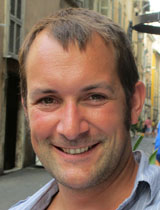 MSc, PhD (Otago)
MSc, PhD (Otago)